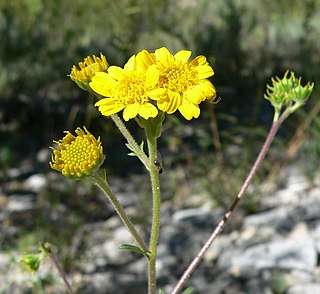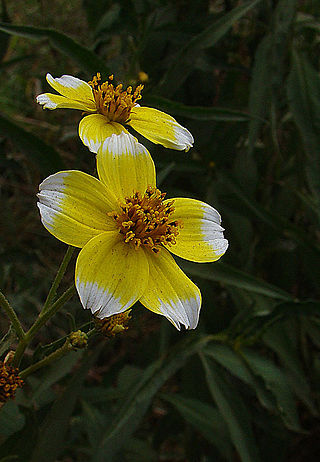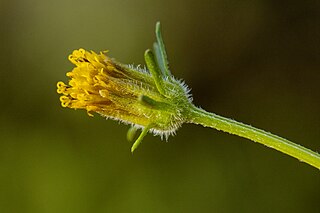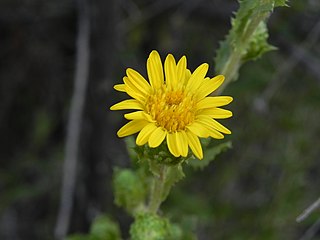
Zinnia acerosa is a low-growing perennial flowering plant native to the Southwestern United States and Northern Mexico. Common names include desert zinnia, wild zinnia, white zinnia, and spinyleaf zinnia. It is a popular landscape plant in the southwest due to its low water use and long bloom period. The flowers also serve as a food source for southwestern butterflies.

Isocoma pluriflora, commonly called southern jimmyweed or southern goldenbush, is a North American species of flowering perennial herbs in the family Asteraceae. It grows in northern Mexico and in the southwestern and south-central United States.

Ericameria cuneata is a species of flowering shrub in the family Asteraceae known by the common name cliff goldenbush. This plant is native to the southwestern United States and northwestern Mexico.
Helianthus niveus is a species of sunflower known by the common names showy sunflower and snowy sunflower. It is native to northern Mexico and the Southwestern United States.

Hymenothrix is a small genus of North American flowering plants in the daisy family known as thimbleheads. They are native to the southwestern United States and northern Mexico.

Thelesperma, commonly known as greenthreads, is a genus of annual or perennial herbs and subshrubs found in the Americas. Members of this genus are closely related to some species of Coreopsis and Bidens. The genus is considered to be within the family Asteraceae.

Bidens aurea , the Arizona beggarticks, is a North American species of flowering plant in the family Asteraceae. It is widespread across much of Mexico and found also in Arizona and Guatemala. The species is also naturalized in parts of Europe and South America.

Bidens bigelovii, commonly called Bigelow's beggarticks, is an annual herbaceous flowering plant in the Asteraceae family. It is native to the southwestern and south-central United States and as far south as Oaxaca, Mexico.
Bidens heterosperma, commonly known as the Rocky Mountain beggarticks, is an annual or perennial, herbaceous, flowering plant in the family Asteraceae, tribe Coreopsideae. It is native to northwestern and north-central Mexico, and portions of the southwestern United States.
Bidens lemmonii is a North American species of flowering plant in the family Asteraceae. It is native to the southwestern United States and Mexico.

Bidens tenuisecta , the slim lobe beggarticks, is a North American species of flowering plant in the family Asteraceae. It is native to northern Mexico (Chihuahua) and the western United States. There are also reports of populations in the northeastern United States but these are almost assuredly introductions.

Brickellia floribunda, the Chihuahuan brickellbush, is a North American species of flowering plants in the family Asteraceae. It is native to northern Mexico and the south-western United States.

Coreocarpus arizonicus, the little lemonhead, is a North American species of flowering plants in the daisy family native to northwestern Mexico and the southwestern United States. It has been found in southern Arizona, and in the adjacent Mexican States of Sonora, Chihuahua, Sinaloa, and Baja California Sur.

Coreopsis intermedia, the goldenwave tickseed, is a North American species of plants in the family Asteraceae. It is native to a small region in the south-central United States (eastern Texas, western Louisiana, southwestern Arkansas.
Cosmos pacificus is a Mexican species of plants in the family Asteraceae. It is native to southwestern and west-central Mexico from Sinaloa to Chiapas.

Dieteria asteroides, the fall tansyaster, is a North American species of plants in the sunflower family. It is native to the southwestern United States and northern Mexico.

Erigeron tracyi is a North American species of flowering plant in the family Asteraceae known by the common name running fleabane. It is native to northern Mexico and the southwestern United States.
Helianthus laciniatus is a North American species of sunflower known by the common name alkali sunflower. It is found in the southwestern United States and north-central Mexico. It is fairly common in the Chihuahuan Desert.

Solidago lepida, the western Canada goldenrod or western goldenrod, is a North American plant species in the genus Solidago of the family Asteraceae. It is widespread across much of Canada, the western United States, and northern Mexico.

Hazardia berberidis is a species of flowering plant in the family Asteraceae commonly known as the barberry-leaf goldenbush. A woody shrub, it is characterized by sawtooth leaves and yellow ray flowers that bloom from March to August. It is endemic to the coastal sage scrub and coastal succulent scrub habitats of Baja California, Mexico, but with populations of uncertain origin in San Diego County, California.















